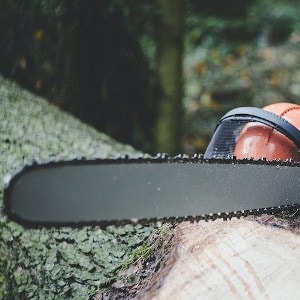 Chainsaw chains get worn out. It just happens. When you spend a lot of time cutting through thick wood with your chainsaw, it is only natural that the chain eventually gets worn down. The most important thing is to keep your eye on the chain and understand when it is worn beyond repair.
Chainsaw chains get worn out. It just happens. When you spend a lot of time cutting through thick wood with your chainsaw, it is only natural that the chain eventually gets worn down. The most important thing is to keep your eye on the chain and understand when it is worn beyond repair.
If you continue to use a worn chain, you are inviting disaster. A worn chain will not function the way it should, making it extremely hard to cut anything. It can even hurt your engine over time. Not to mention, a worn chain is more prone to snapping, which could cause serious physical damage to you.
The point is that you should always have a sharp chain. A sharp chain will save you physical harm, and it will save you a lot of energy. A chain that is worn and dull will put more strain on you, as you will need to work harder to cut simple things. Even cutting something as easy as a tree branch will become a huge pain in the neck.
Do All Chainsaw Chains Wear Out?
People are always asking if every kind of chainsaw chain wears out. This is totally understandable, seeing as there are very expensive chains on the market that are advertised as being better and stronger. And while you can definitely spend money on a more expensive chain, it is still going to get worn out eventually. There are no unbreakable chainsaw chains!
A standard chain that comes with your chainsaw is probably going to wear out faster than a quality replacement chain, it’s true. But every chainsaw chain will eventually wear out.
The good news is that there are some fixes to a worn-out chain. You can always sharpen the tool yourself at home, you can take it to your local hardware store to get them to sharpen it, or you can simply replace the old one with a new one. The most important thing is to always recognize when your chainsaw chain is worn out. The sooner you recognize the problem, the sooner you can fix it.
Read More: How To Sharpen A Chainsaw – Beginner’s Guide
When is Your Chainsaw Chain Worn?
There are a few key things that happen when your chainsaw chain becomes worn out. It will stop performing correctly, it will make it much more difficult to cut wood, and it could even smoke.
Cutting Performance
You’ll undoubtedly notice the first thing to go is the cutting performance. As your chain gradually gets duller, it stops working the way it should. This is most noticeable with your chainsaw no longer wanting to cut through wood. If you notice that the efficiency of your chainsaw has been steadily declining, it is definitely due to a worn chain.
When your chain has sharp teeth, it works to cut wood very quickly. This is the whole point of a chainsaw. But once the teeth have cut through enough wood, they will become dull and blunt, and they won’t slice through wood anymore. It will be like trying to cut through a tree with a dull hammer.
One of the most obvious signs will be the discharge while cutting. Normally, your chainsaw will produce big chunks of wood during operation, like woodchips and splinters. Once the chain is dull, it will begin to produce something more like dust, like a really thin sawdust. This is clear evidence of a worn chain.
It should also be noted that if you have to put too much effort into making a cut, it means you have a dull chain. You should never need to force the chainsaw through a branch or a piece of wood. The chainsaw should always have enough cutting power to glide effortlessly through the wood.
If you find yourself pushing hard down on the chainsaw to finish your cut, it is because you have dull teeth on your chain. You should stop work immediately and sharpen the chain to prevent any possible accidents from happening.
Read More: Chainsaw Chain Sizes Chart – Chains Explained
Smoke
Smoke is a huge sign of a worn chain. When your chainsaw is no longer cutting properly, there might be a lot of friction going on during operation. A normal chainsaw will not smoke, as the operation of the machine is supposed to be smooth and free of friction. But if the lubrication system has stopped working, if the tension is not properly adjusted, or if your chain is simply too worn, the dramatic amount of friction will eventually cause smoke.
If you ever see smoke slowly rising from the cut, it is because your chainsaw’s teeth have become too dull. They are causing way too much friction and the heat is building up while you are trying to make a cut.
This is a really good way to damage your chainsaw, so I highly recommend you sharpen your chain teeth the moment you see smoke.
Read More: How To Replace A Chainsaw Chain – 3 Easy Steps
Uneven Performance
Even if your chain is not smoking, and even if your chainsaw is still cutting through wood without any problems, you may start to notice uneven cuts and a shaky performance. These are other signs that your chainsaw is in need of a desperate sharpen.
You see, when the teeth have become uneven, they will start to make awkward cuts. You will notice that your cuts are deeper on one side than the other. This is because some teeth are dull and others are not, making the entire act of cutting uneven.
Also, if you notice your chainsaw feels to be jerking around, rattling excessively, or even bouncing back at you and cutting in an uneven line, you definitely need a new chain, or to sharpen the one you already have.
Read More: Best chainsaw under 400 dollars
How To Tell When A Chainsaw Chain Is Worn Out: Final Thoughts
If you are experiencing any of these symptoms with your chainsaw, it is time to sharpen the chain. If you don’t have a file to sharpen the chain with at home, you can always go into your local hardware store and purchase a chainsaw sharpening kit.
Never continue working with a dull chainsaw. It is not safe for you, it is not safe for your chainsaw’s engine, and it is a cheap thing to fix.
Read More: How To Put A Chain On A Chainsaw – Easy 3 Steps Guide

